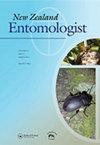Hylastes将防护林松树用作农业景观中的“垫脚石”
IF 0.6
4区 农林科学
Q4 ENTOMOLOGY
引用次数: 6
摘要
摘要:Hylastes ater和Hylurgus liniperda是新西兰的两种外来松树皮甲虫,最近在远离松树种植园或其他死亡松树宿主材料的地方被采集到。我们调查了分散的甲虫是否在新西兰农业景观中常见的防护林(防风林)受损松树的根部和根部繁殖。以前已经注意到这些树皮甲虫在根和根环中繁殖的能力,主要是在枯树和树桩上。但据我们所知,新西兰尚未对直立但生理衰退(即死亡)的树木的根部是否可以作为合适的繁殖材料进行实证研究。我们使用了一种新的、有效的根食草动物出现陷阱,也就是这里所描述的,来进行这项研究。坎特伯雷内陆的13个陷阱和三个地点共捕获了37只H.ater;但未发现木质素线虫。我们证实,H.ater能够在受损和衰退的孤立松树的根部定居,并表明防护林可以作为“垫脚石”,帮助其在景观中传播和持续。本文章由计算机程序翻译,如有差异,请以英文原文为准。
Use of shelterbelt pine trees as ‘stepping stones’ by Hylastes ater in agricultural landscapes
ABSTRACT Hylastes ater and Hylurgus ligniperda, two exotic pine bark beetles in New Zealand, have recently been collected at locations far from pine plantations or other dead pine host material. We investigated if dispersing beetles are reproducing in the roots and root collars of damaged pine trees of shelterbelts (windbreaks) that are common in New Zealand’s agricultural landscapes. The ability of these bark beetles to breed in roots and root collars has been noted previously, primarily on dead trees and stumps. But to our knowledge it has not been empirically studied in New Zealand if roots of standing but physiologically declining (i.e. dying) trees can serve as suitable breeding material. We used a novel and effective root herbivore emergence trap, which is described here, to carry out this study. A total of 37 H. ater were captured across 13 traps and three sites in inland Canterbury; however, no H. ligniperda were found. We confirm that H. ater is able to colonise roots of damaged and declining isolated pine trees and show that shelterbelts can act as ‘stepping stones’ aiding spread and persistence through the landscape.
求助全文
通过发布文献求助,成功后即可免费获取论文全文。
去求助
来源期刊

New Zealand Entomologist
ENTOMOLOGY-
CiteScore
0.70
自引率
33.30%
发文量
3
审稿时长
>12 weeks
期刊介绍:
The invertebrate diversity of New Zealand is of great interest worldwide because of its geographic isolation and geological history. The New Zealand Entomologist plays an important role in disseminating information on field-based, experimental, and theoretical research.
The New Zealand Entomologist publishes original research papers, review papers and short communications. We welcome submissions in all aspects of science regarding insects and arthropods in a New Zealand or Australasian setting. The journal’s subject matter encompasses taxonomy, phylogenetics, biogeography, biological control and pest management, conservation, ecology and natural history.
The journal is the official publication of the Entomological Society of New Zealand. Papers published or submitted elsewhere for publication will not be considered, but publication of an abstract or summary elsewhere (e.g. conference proceedings) does not preclude full publication in the New Zealand Entomologist. Accepted papers become copyright of the Entomological Society of New Zealand. The journal is published in English, but we also welcome publication of abstracts in Maori.
 求助内容:
求助内容: 应助结果提醒方式:
应助结果提醒方式:


